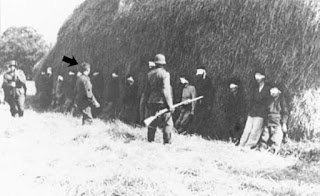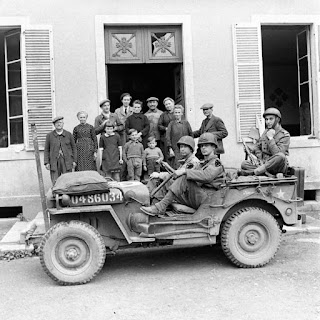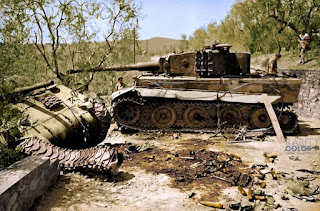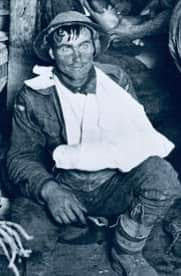American artillery eventually rain down and silence the enemy guns
April 3, 1945. The drive toward Gotha continued. Combat Command A moved swiftly until reaching the vicinity of Leina, where a combination of a blown overpass and two batteries of 88mm dual-purpose guns brought Colonel Sears' command to a dead stop. American artillery would eventually rain down and silence the enemy guns, but not before CCA lost 6 tanks, a 105mm assault gun, two half-tracks and two peeps.
While CCA tangled with the beehive of 88s, Lt. Colonel Abrams' CCB made a smooth, uneventful advance toward Gotha. By 1300, Abrams' tanks and armored infantry occupied the high ground overlooking the city. An attack launched into the city met heavy resistance and was forced to withdraw after nightfall. The 35th Tank Battalion and 51st Armored Infantry Battalion established defensive positions on the outskirts of the city.
Earlier that day, a trial convened involving two soldiers from the 704th Tank Destroyer Battalion. Both of the accused pleaded not guilty to the charges and specifications. It took three hours to present the evidence before a Law Member and five other officers. After the defense made its oral argument, a secret ballot was cast, and both men were found guilty. Their sentence was initially to be “hanged by the neck until dead.”
This is their story.
The destroyed bridge on the Nahe River that produced the delay at Langenlonsheim on March 17 also led to a darker side of the division’s history. It was here that two of the Fourth Armored’s own reflected the reality that a division of more than ten thousand men is bound to be a mirror of a broader society. While the overwhelming majority of men that comprised Olympic were of good, decent, and moral character, there were exceptions.
At Langenlonsheim, three German women were raped (one being only sixteen years old). Two soldiers from B/704 were accused of the crime. One of the men…25 years old at the time, a husband and father of a young son…had a clean record prior to this. His 19-year-old partner was a different story, as he possessed a past record that included two prior special courts-martial convictions (one for being absent without leave for eight days and the other for larceny of clothing) and a conviction by summary court “for leaving properly appointed places of duty in violation of Article War 61.”
The two G.I.s entered Langenlonsheim the evening of March 17 (according to later testimony, in search of another soldier). They entered a cellar where they found some sixty civilians, most of them women and children. The vulnerable citizens were taking refuge from artillery fire.
What happened after that would change many lives, both soldier and civilian, both in Germany and America.
Two American soldiers together victimized the three aforementioned women. One soldier overcame the resistance of the 16-year-old girl and raped her twice. He was also accused of attempting sodomy. He and the other soldier were both accused of raping the same 23-year-old woman.
The other soldier was reported to have turned his gun toward yet another victim…a 28-year-old woman who was in the company of her 8-year-old son…and proceeded to rape her, rendering her unconscious during the act.
Quick justice was dealt out. In fact, as would later become evident, perhaps too quick. An unidentified member of the 704th Tank Destroyer Battalion came forward and materially corroborated at least part of the testimony of the victims. The following morning, the two soldiers were informally accused. They were taken back to the town and placed in front of the victims and other German witnesses in order to be identified. At that point, none of the civilians identified either of the two men as the culprits. Nevertheless, the two soldiers were taken into custody and transported back to the 704th’s headquarters.
Later that day (March 18), 2nd Lt. William L. Kline, the relatively new Battalion Adjutant for the 704th, was appointed to investigate the incident. He traveled to Langenlonsheim with an interpreter and a stenographer and interviewed several witnesses.
On March 21, Lt. Kline returned to the town with the two accused soldiers in tow. He placed them before the witnesses, and this time, nearly all of them identified one of the soldiers as being the rapist. Half of the witnesses agreed upon the identity of the other soldier (the elder of the two). Several witnesses were unsure altogether, and several picked out a soldier known with certainty to not be in the town on March 17.
Lt. Kline provided the 704th’s commanding officer (Lt. Colonel Bidwell) with the results of his investigation. Bidwell consulted with Lt. Colonel Chester D. Silvers, the Fourth Armored’s Judge Advocate. Silvers felt the men were guilty and should be charged accordingly.
On March 29, Kline and Silvers worked together to draw up the charges. The charges were sworn to by 1st Lieutenant Marion E. Taake, and on March 31, Lt. Colonel R.M. Connolly, Adjutant General of the Fourth Armored Division, referred the charges to Major Lowell A. Spires, trial judge advocate. On April 1, Lt. Kline read the charges to the accused (both men had been detained since March 18). At 1700 on April 2, the accused were notified that their trial would commence the following day at Jügesheim, Germany.
Dr. Joseph J. Frank (a major in the Medical Corps) was appointed to defend the accused at trial. The older of the accused requested that the 704th’s Captain Evans defend him (Evans having had some experience at previous court-martial proceedings). Major Frank attempted to arrange for Evans to assist, but he was unable to pull it off. The same soldier also asked for a number of witnesses to be brought to the trial; men that might vouch for his conduct at the cellar and for his overall character. But with B/704 now fighting well to the east, none of the witnesses were able to appear.
Then, on April 3, came the trial, plea, and verdict.
On April 12, Lt. Colonel Silvers submitted his review of the proceedings. He upheld the findings, but recommended that the sentence (if confirmed) be mitigated to dishonorable discharge, total forfeitures and confinement at hard labor for life.
The case received further review on July 5 by the Staff Judge Advocate and again on August 29 by the Branch Office of the Judge Advocate General with the European Theater. The review pointed out while some irregularities had occurred in the proceedings, the rights of the accused had been sufficiently guarded. The sentence was amended to “Dishonorable discharge, total forfeitures and confinement at hard labor for life. United States Penitentiary, Lewisburg, Pennsylvania.”
The story did not end there, however.
The place of confinement was subsequently changed to the United States Penitentiary at Leavenworth, Kansas. The eldest of the accused maintained his innocence, and in May of 1947, he came before a judge in the U.S. District Court for the District of Kansas. On May 27 of that year, he won a victory in court. From the ruling:
“In view of the conclusion reached it is unnecessary to review at length the other contentions made by petitioner. The inability of Lt. Kline to produce, at the trial, the desired witnesses, the circumstance that petitioner was defended rather ineptly as might be expected by a medical officer instead of by one trained in the law, the fact that he was required to go to trial the second day after the charges were filed and the suggestion that the reviewing authority might appropriately have set aside the findings of guilt as not supported by the evidence, individually and collectively might have justified this court in plagiarizing some of the language used by Judge Biggs, Senior Judge of the Circuit Court of Appeals for the Third Circuit in Hicks v. Hiatt, D.C., 64 F. Supp. 238. It has chosen, however, to rest its conclusion that petitioner is illegally detained and restrained of his liberty by the respondent upon the grounds discussed.
Order releasing petitioner from custody is this date being entered. Inasmuch as it is reviewable, 28 U.S.C.A. § 463, a good and sufficient bond, conditioned according to law, in the amount of Two Thousand Five Hundred ($2,500.) Dollars, to be approved by the clerk of this court, is being made a condition precedent. Rule 45, Rules of the Supreme Court, 28 U.S. C.A. following section 354.”
There is no doubt that serious crimes were committed in Langenlonsheim. One can only hope that the women victimized in the war-torn town were able to recover both physically and emotionally. Whether the full weight of justice was ever delivered to their attackers – no matter who they may be – is unknown.
The rush to bring the accused before a court martial was at least in part driven Lt. Colonel Silvers opinion that, according to court records in the 1947 case, “they should be made an example of for disciplinary purposes.”
The desire to maintain discipline is understandable. That it was done in this manner, without sufficient attention to due process, is regrettable. But just as the actions of the attackers reflected the underbelly of society, the actions of the prosecutors in this case reflected what happens when discipline and fairness is not maintained within our system of justice. The lessons apply in war just as they do in peace.
Patton's Vanguard - The United States Army Fourth Armored Division











Comments
Post a Comment